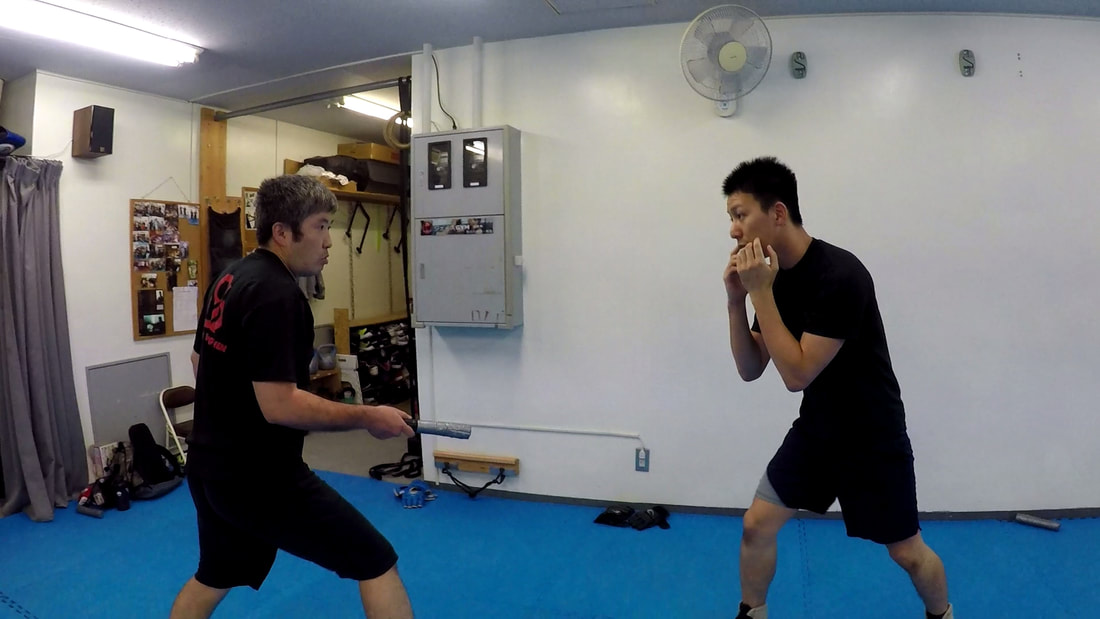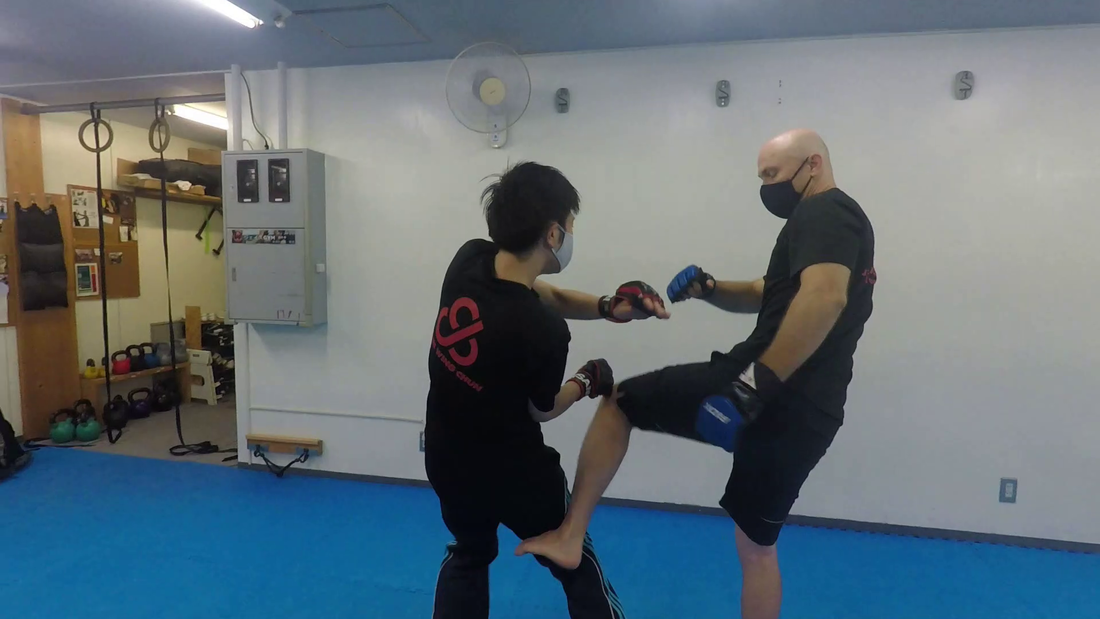|
以前ネットでこのようなテキストを見つけました:
“I’m using my longest weapon, my side kick against the nearest target, your kneecap. This can be compared to your left jab in boxing, except it’s much more damaging.” – Bruce Lee "私は私が持つ最も長い武器であるサイドキックを最も近いターゲットに使う。あなたの膝だ。このサイドキックはあなたのボクシングの左ジャブのようなものだ。ひとつちがうのは(私のサイドキックのほうが)はるかにダメージが大きいことだ。" ブルース・リー より はじめに言っておくと、私はブルース・リーのファンです。しかし、あなたが誰かのファンであっても、その人もあなたと同じ人間であり、完璧ではありません。 ブルース・リーは若くして亡くなりましたが、その短い生涯のなかで多くの言葉や文章を遺しました。しかし彼は彼の言葉がどのように使われるかは決められませんでした。彼の言葉は彼の意図とは違う使い方をされることがあります。そして彼はもう彼の言葉を訂正することはできないのです。 詠春拳のインストラクターとしてわかったことの一つは、武術の理解は変化し深くなっていくということです。 自分では理解したと思っていても、実際には、その時、わかっていないこともあります。少し分かっていたかもしれないが数年後のもっともっと深い理解と比べると、分かっていなかったようです。 ではジークンドーのサイドキックとボクシングのジャブの長所と短所を比較をしてみましょう。 ブルース・リーはサイドキックをジャブのようだと言いましたが、私はたたかうときの始まりと、たたかっている最中に使うという意味だと考えました。フィニッシュには使いません。(詠春拳ではほぼフィニッシュとしてしか使わないです。) サイドキックは敵の膝に対して適切な角度、間合い、タイミングで当たったときに(もしくはそのときだけ)よりダメージを与えます。 一般的なキックの問題はパンチよりもおそいことです。もしジークンドーの使い手とジャブを使うボクサーのどちらの攻撃が先にあたり、より効果的かという賭けなら私はボクサーにお金を賭けます まずジークンドーのサイドキックについて: キックをするためには体重を移動しなくてはなりません。 キックが高すぎても低すぎても思うような効果は得られず、また、反撃を受けやすくなります。 距離についても同じ:近すぎると弱く、遠すぎてもあたりません。 タイミング:敵が動いていたらどうでしょう?膝はかなり小さいターゲットで、タイミングが合わせにくく、動いているときにはあたりにくいターゲットです。 ではジャブについて: ジャブは多くの準備を必要としません。体重移動もわずかです。 ターゲットは敵の頭部なので膝より大きくて狙いやすい部分です。反撃されることもありますが、次の動きに続けやすいです。 距離についてもジャブの目的から考えると重要な要素ではありません。ジャブの目的は敵との距離を計り敵を次のパンチに追い込むことです。 タイミングについてはさらに簡単です。キックよりパンチの方が方向を変えやすいためです。しかしターゲットとしては膝より頭の方がよく動くので大きな力を与えにくい時もあると考えられます。 サイドキックとジャブの違いのまとめ: ダメージの点ではキックがより効果的なのは疑う余地はありません。 リスクの点ではジャブよりキックの方が危険性がはるかに大きいです。ターゲットが小さく、体重移動に時間がかかり、タイミングも困難です。 平均的な人にとってはジャブの方がよりよく、より安全なテクニックです。 ブルース・リーのサイドキックは特別なものであったことも考えられますが、彼のようなスピードを得られる可能性は極めて小さいことでしょう。 私がもしこれらの2つのテクニックのどちらかを実践するとしたらジャブを選びます。(詠春拳ではジャブを使うことはありませんが) それでもブルース・リーはサイドキックへのこだわりは捨てなかったかもしれません。 日本語版 https://www.jsgym.net/blog/jeet-kune-do-sidekick-vs-boxer-jab
I came upon this quote on the internet a while ago: “I’m using my longest weapon, my side kick against the nearest target, your kneecap. This can be compared to your left jab in boxing, except it’s much more damaging.” – Bruce Lee First of all, I am fan of Bruce Lee of course but when you're a fan you sometimes forget that the person you're a fan of is a person, just like yourself. And people are not perfect. Since Bruce Lee died way too young, but nevertheless managed to say and write a lot during his brief time on earth, he cannot control how he's statements are being used (which are often taken out of context for business purposes). And he cannot make corrections to his previous statements. One of the things I've learned during my time as a wing chun teacher is that your understanding of martial arts changes and deepens. What you thought you understood, you really didn't understand at that point in time. At least not to the extend you might do many years later. Now let's get back to the JKD side kick and try to compare it with the boxer's jab and look at the pros and cons. Since Bruce compares it with a jab I'll consider it used in the beginning and during fight, and not as a fight ending last attack (the only way I would use it as a wing chun practitioner!): The side kick might be more damaging if, and only if, it connects with the kneecap at the right angle, at the right distance, with the right timing. The problem with kicks in general is that they are slower than punches so if we were to put a side kicking Jeet Kune Do practitioner up against a jabbing boxer, my money is actually on the boxer using a jab rather than the JKD side kicker if asked who hits first, or benefits the most from the attack. First, the Jeet Kune Do side kick: In order to kick you need to transfer your weight first. If your kick is too high or low you don't get the effect that you were wishing for and you might have opened yourself up to a counterattack. The same goes for the distance: too close and the kick is weak, too far away and you miss the target completely. Timing: What if the opponent is moving? The kneecap is a rather small target and it's probably easy to time the kick wrongly and miss the target when there's movement involved. Now let's look at the boxer's jab: There's very little preparation needed for a jab. No need for transferring much weight. The target is the opponent's head, which is bigger and easier to hit than a kneecap. A counterattack is almost always a possibility but you're in a better position to follow up than after a side kick. Distance doesn't matter as much as the purpose of the jab is to measure distance and set your opponent up for the next punch. Timing is easier because it's easier to change direction on a punch than a kick. But the target is more moveable than the kneecap which can make it difficult to hit the target with a lot of power. Let's recap: When it comes to damage, the side kick wins. No doubt about that. When it comes to risk assessment, the side kick will often be much more risky than the jab because of the small target, time needed for transferring of weight, difficult timing, etc. So for the average person the jab is probably the better and safer technique. For Bruce Lee, maybe his kicking ability was one of a kind but the chance of you being as fast as Bruce Lee is minimal. I would practice the jab if I had to choose between the two techniques (though there's no use for a jab if you're using wing chun). Bruce Lee on the other hand, might never have changed his fondness for the side kick. よく護身術について聞かれることがあります。 たとえば合気道やロシアのシステマ、インドネシアのシラットについてどのように考えるかなどです。 そして詠春拳とジークンドーのどちらがよいかということも。 これらの質問にかんたんに答えると ”合気道は護身術としては特別によいものではありません” このことはいつか書きます。 今言えるのは、合気道を学ぶのは護身術ではなく他によい理由があるからだということです。 私が知る、または試してみたロシアやインドネシアの武術、キックやつかみ技のシステムの中で、私の目標にあったものはありませんでした。 私の目標とは: 最良で、最もシンプルで役に立ち、防御できて、たたかえる方法です。 その方法を、どんな状況でも、だれでも、背や体重関係なく、使えなくてはなりません。 それは早くて、敵をすぐに止められるものでなくてはいけません。 (たくさんの持久力を高めるトレーニングは必要ないように。) このシンプルな方法では、立ってたたかい、テイクダウン、複数の敵や、武器を持った敵に対応できる方法です。 どんな場所でも、逃げられない場所や逃げられる場所でも使えます。 この目標を考えると詠春拳とジークンドーのどちらをえらぶかはかんたんです。 詠春拳のほうが実際のたたかいにはすぐれています。 多くの(日本の)ジークンドーは映画のように速く見えますが、十分に役に立つテクニックではありません。 (しかし、すべての日本のジークンドーがこのようなものではありません。素晴らしいジークンドーのインストラクターに会えるかもしれません。 同じように私が詠春拳のことを書くときは ジェイスジム詠春拳のことです。) You can also find an English version of this on the blog page:
https://www.jsgym.net/blog/faq-about-self-defense-and-other-systems-and-our-goal 生徒の中、回し蹴り好きな人結構いるので回し蹴りのいいところと良くないところについて動画を作ってみました。 強い技のイメージがあると思いますが回し蹴りの使え道はとても限られています。 多くの人はリングの上やオクタゴンの中で使える技は当然に強いと思っていますが状況が変わるとどういう技が強いかも変わります。 実は、回し蹴りを使ってる詠春拳流派もあります。その流派の目標はきっと私たちの目標と異なります。 とにかく、回し蹴りは詠春拳で戦っている人には役に立たないです! I often get asked about self-defense and for example aikido or what do you think about Russian (Systema) or Indonesian (Silat) martials arts? And which is better, wing chun or Jeet Kune Do (JKD)?
The short answer to all of these is that Aikido is not very good self-defense. I'll write more about why not some other time. For now just trust me, choose Aikido for all other reasons than for self-defense. I haven't seen or tried any Russian, Indonesian martial arts, kicking or grappling arts, that has much to offer to my goal which is: to find the best, most simple and effective way to defend and fight for yourself under any circumstances, for any person no matter height and weight. And it has to be speedy, enabling the practitioner to stop the opponent quickly to avoid the need for lot's stamina training). Furthermore, this simple method has to be able to deal with standup fighting, takedown attempts, attacks by multiple opponents and opponents armed with weapons. All of these attacks have to be able to be dealt with on any surface and both in a confined or in an open space. So considering my goal choosing between Wing Chun and JKD is easy. Wing Chun is just much better for realistic fighting, whereas a lot of (Japanese) JKD seems to be for actors looking for fast and flashy looking but not necessarily effective techniques. (But all Japanese JKD might not be the same, like not all wing chun is the same. So you might be lucky to find a great JKD teacher, likewise when I write about wing chun, it's only about J's GYM wing chun.) アダプタビリティと無限に連続している技 アダプタビリティ(適応性)は、ブルース・リー(JKDの作成者)が「水のようになる」と呼んだことです。ジェイスGYM詠春拳では、形(手技)を変えて相手の攻撃に対応しようとしていますが対戦相手に技を「選択」させます。 無限な技とは、技を沢山使っているという意味ではありません。逆に、少ない技を連続して、無限な攻撃と防御的な動きで戦うことです。 この戦い方は、ほとんどの武道(ジークンドー含めて)で使用されているパンチ/キックのコンビネーションとは大きく異なります。詠春拳の「無理しない」と「前へのプレッシャー」のコンセプトを使わないとできないです。 English: Adaptability (Wing chun) is what Bruce Lee (creator of JKD) called to "be like water". At J's gym wing chun we try to adapt our responses to the opponent's attack by changing shapes (read techniques) and let the opponent "choose" our techniques for us. Infinite techniques do not mean that we have a lot of techniques but that we connect a few techniques into an infinite chain of attacks and defensive moves. It's very different from a punch/kick combination as used by most martial arts. Blocking often works poorly against a stronger opponent and so we should only use it as a last resort. Instead, we focus on deflecting attacks and when possible to use the opponent's force against him. |
J's GYMとは
|
入会方法
|
|







